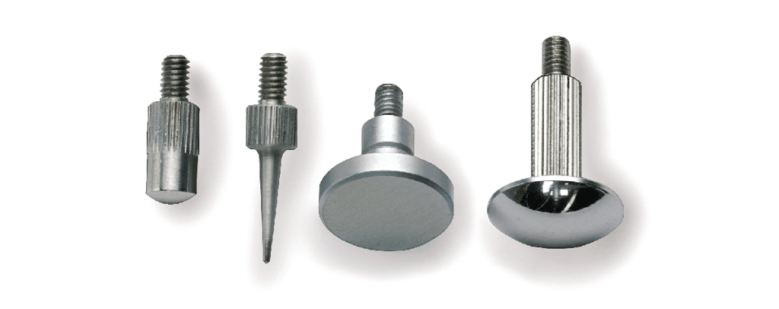The contact point on an indicator, whether dial or digital, is the point of interaction between your tool and your part. This very important piece of the indicator comes in a variety of types and is typically replaceable depending on your current needs. While for some metrologists it may be common practice to have a standard indicator and contact point laying around the workshop, the truth is that there are numerous reasons why the contact point might be changed or altered in some way. The important message to remember is that indicators have other types of points that you may not have heard of yet. We would like to tell you about a few of them.
Indicator contact points come in many different types that vary by shape. Each shape has its respective purpose for which it will provide the ideal measurement, with some overlap. The most standard shape for a contact point is the ball point. The ball point contact point is optimal for workpieces that have deep indentations. The shell type point contact point of an indicator has a large radius, making it ideal for use on flat surfaces. A spherical point also comes built with a large radius and is most optimally used when the workpiece you are measuring needs to slide from side to side. A contact point with a conical point shape is commonly used for positioning the measurement point. This point requires a certain amount of care since it can easily damage a workpiece and therefore should be avoided when measuring softer materials. A flat point, sometimes known as a flat button point or wide face flat point, is the optimal design for use on convex surfaces. A knife edge point is more ideal for measuring the diameter of narrow grooves. An indicator contact point with a needle point shape is the most suitable choice when you need to probe the bottom of a groove or hole. The blade point shape is used often on convex surfaces, particularly when they have shallow grooves on them. Finally, the roller point shape of contact point is best suited for moving workpieces, such as when it needs to be moved and slide from side to side.
Beyond the actual shape of the indicator contact point, these important parts come in different material types as well. The most commonly used materials include carbide, ruby, plastic, and steel. Ruby is great with delicate parts and comes with incredible compression strength and resistance to corrosion. You will want to avoid using ruby with harsher metals. Carbide may be the most commonly used contact point material for an indicator. By far, carbide is the most durable option, with an unbeatable compressive strength and long-term economic benefits. Overall, it is important to consider the environmental impact, melting points, magnetic properties, and thermal expansion of each of the materials you are considering.
Finally, you may want to consider using an extension for your indicator contact point. Depending on the parts or distances you need to measure, as well as the available tools at your disposal, the option of extending the contact point itself can prove incredibly useful. Extensions for an indicator contact point may range from ¼” to 8” and do not add too much to the overall cost. You will want to make sure that the extension you are using pairs with your particular brand of indicator in order to ensure measurement precision.
Choosing the correct contact point type for your indicator is crucial to maintaining accuracy. Depending on the material involved in your measurement process, there are a variety of indicator contact point types that you can explore. A few of the ways you can alter your indicator contact point include its shape, its material, and whether or not you use an extension. Indicators do have other types of contact points and they are important to accurate and precise measurement.

